| Article ID | Journal | Published Year | Pages | File Type |
|---|---|---|---|---|
| 2808580 | Neuropeptides | 2009 | 12 Pages |
Angiotensin II (Ang II) and its type-1 receptor (AT1) occur in neurons at multiple locations within the organism, but the basic biology of the receptor in the nervous system remains incompletely understood. We previously observed abundant AT1-like binding sites and intense expression of AT1 immunoreactivity in perikarya of the dorsal root ganglion and ventral horn of the rat spinal cord. We have now examined the receptor in rat sciatic nerve, including the dynamics of its axonal transport. Ligand-binding autoradiography of resting nerve showed “hot spots” of 125I-Ang II binding that could be specifically blocked by the AT1 antagonist, losartan. Immunohistochemistry with an AT1-antibody validated by Western blots also showed patches of AT1-reactivity in nerve. These patches were localized around large myelinated axons with faint immunoreactivity in their lumens. Sixteen hours after nerve ligation there was no change in the patches or hot spots, but luminal AT1-reactivity increased dramatically in a narrow zone immediately above the ligature. With double ligation there was a pronounced accumulation of AT1 immunoreactivity proximal to the upstream ligature and a very slight accumulation distal to the second ligature. This asymmetric pattern of accumulation, confirmed by quantitative receptor binding autoradiography, probably reflected axonal transport rather than local production of receptor. Retrograde tracing and stereological analysis to determine the source of transported AT1 indicated that many AT1-positive fibers arise in the ventral horn, and a larger number arise in dorsal root ganglia. A corresponding result was obtained with double-label immunohistochemistry of ligated nerve, which showed AT1 accumulations in both motor and sensory fibers. We conclude that somatic sensory and motor neurons of the rat export substantial quantities of AT1 into axons, which transport them to the periphery. The physiologic implications of this finding require further investigation.
